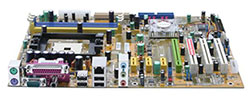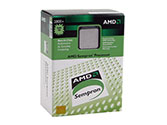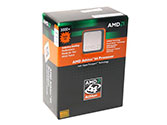Entry Level Buyer’s Guide, July 2005
by Jarred Walton on July 20, 2005 12:05 AM EST- Posted in
- Guides
AMD Recommendations
We have our base recommendation as well as an upgraded recommendation for the AMD side of the equation. The two systems are similar in many areas, but the choice of motherboard, CPU, and graphics card sets them apart.  |
 |
| Click images to enlarge. | |
Budget Socket 754 Motherboard: Foxconn nForce4 NF4K8AB-RS
Price: $78 shipped
Budget Socket 754 CPU: AMD Sempron 2800+ 1.6 GHz 256KB L2 (Retail)
Price: $83 shipped (Retail)
Total: $161
While our basic CPU recommendation remains the same as our last Budget Guide, you'll notice that we've switched motherboards. The main advantage of the Foxconn board is that we get a PCI Express slot, making it a more future-proof solution. Foxconn boards in the past have generally been conservative in approach, but early reports are that this particular board includes overclocking features that should allow you to reach at least a 250 MHz CPU bus if you're interested. (Our own tests with a similar Foxconn board for 939 maxed out at 235 MHz, though, so take those claims with a grain of salt.) The 8X multiplier of the 2800+ is the true limiting factor, giving you a range of 1.8 to 2.4 GHz for a 225 to 300 MHz bus - we figure that the Foxconn board will limit you to 2.0 GHz at best, though we have few doubts that the 90nm Sempron chips can easily run at that speed and more.
If you want better overclocking support, the EPoX EP-8NPAJ or ASUS K8N4-E Deluxe is probably a better choice. Our top pick for socket 754 overclocking continues to be the DFI LANPARTY UT nF3 250Gb, but you'd have to return to an AGP graphics card with the DFI board and we're hesitant to recommend that. The EPoX board only costs another $11, so it's a worthwhile upgrade for the enthusiasts, but the ASUS and DFI boards are quite a bit more expensive. If you're looking at spending that much money on a motherboard, you should probably upgrade to socket 939.
Those interested in cutting costs more can knock off another $11 by dropping to the Sempron 2600+. That has half the cache of the 2800+, but runs at the same clock speed. That should cut performance by about 5 to 7% for a 13% price reduction, but when you look at the total cost of the system, you're really only reducing the price by 2%. Going the other way and upgrading to a Sempron 3000+ or 3100+ is also an option, though the price of the 3100+ is near enough to the Athlon 64 3000+ we list below that we would recommend switching to that platform rather than purchasing a faster Sempron chip.
 |
 |
| Click images to enlarge. | |
Upgraded Socket 939 Motherboard: MSI nForce4 K8N Neo4-F
Price: $85 shipped
Upgraded Socket 939 CPU: AMD Athlon 64 3000+ 1.8 GHz 512KB L2 (Retail Venice core)
Price: $146 shipped (Retail)
Total: $231
For our upgraded AMD setup, we've selected the MSI K8N Neo4-F motherboard with an Athlon 64 3000+. We chose the retail version of the 3000+, though if you're willing to find a suitable HSF, you can get the OEM model for $119 right now. We prefer to avoid the hassle of finding a separate HSF and get the longer warranty, as the total difference in cost after shipping is only about $10. If you want a good overclocking setup, we can vouch for the capabilities of the Neo4-F and the CPU, and when paired with a quality HSF, it's not unusual to hit 2.6 GHz with the Venice cores. We've run some overclocked tests with this CPU and motherboard at 2.2 and 2.4 GHz over a two-week period and didn't experience any difficulties, but your mileage may vary with overclocking.
An alternative to either of these configurations that we've mentioned in the past is the MSI RS480M2-IL 939 board. That includes integrated graphics that are roughly equal to the Radeon X300SE HyperMemory in performance - in other words, the best of the IGP world, but still lacking in 3D performance. While the cost of the board is about the same as that of the Neo4-F, you no longer have to purchase a graphics card. That makes it a wash with the budget setup, but you get a faster CPU. Overclocking is not available on the RS480M2, however, so avoid it if you're interested in tweaking your system for higher performance levels.










57 Comments
View All Comments
bob661 - Wednesday, July 20, 2005 - link
Thanks Jarred.JarredWalton - Wednesday, July 20, 2005 - link
#15 - Bob,OCZ has quite a few overlapping RAM offerings these days, all of which have a place. I recommended the BH5 based Gold that runs 2-2-2-5 1T at 2.8V as opposed to the VX offering that requires 3.2V for 2-2-2-5 1T. Here's the link:
http://www.ocztechnology.com/products/memory/ocz_e...
You can also find the RAM at Newegg:
http://www.newegg.com/Product/Product.asp?Item=N82...
The VX is about the same price, but it doesn't have "Gold" in the name.
----------
WRT the displays, I would much rather have a larger display. Getting people to go from $600 for the basic setup to $750 for a 19" LCD is a tough sell, unfortunately. I really like 19" LCDs (and I like my 2405FPW even more), but few people are willing to shell out over $300 for "just the display". As Hacp mentions, a lot of people just don't realize what they're missing. I know plenty of people with 17" to 19" displays that still run them at 1024x768 - even on LCDs. They just don't realize that resolution is something most people should adjust.
SDA - Wednesday, July 20, 2005 - link
#31, I'm not sure where to start with you.First: Anyone can see the difference between 17" and 19".
Second: You won't notice any difference between a fast system and a (reasonably) slow system when watching movies, writing letters, or surf the web. otoh, you WILL notice a difference between a good monitor and a bad monitor when playing games and editing photos. You're using your monitor every time you're at your computer, but most of the time you don't need a fast CPU at all.
Third: Image quality is important. If image quality wasn't important, people wouldn't buy high-end video cards for games.
IME, people who place I/O equipment (monitor, mouse, sound setup, etc.) at the bottom of the list do so because they have never used genuinely good I/O equipment for any reasonable length of time. I don't mean any offense here, this is just what I've seen.
Zebo - Wednesday, July 20, 2005 - link
sprockkets - just the opposite.. prescott uses about 30% more power than a northwood at same hurtz.. and really starts leaking like crazy after 3.4 which a northwood never saw.Zebo - Wednesday, July 20, 2005 - link
Bob - http://forums.anandtech.com/messageview.aspx?catid...Hacp - Wednesday, July 20, 2005 - link
I doubt that a budgetminded person would recognize the difference between 19 and 17 inches much. Heck, I would even go for a 15 inch LCD if it gave room to get a better video card/cpu or more ram. Screen size is the last thing I think about when I budget for a comptuer.Wellsoul2 - Wednesday, July 20, 2005 - link
The Polywell LCD is a good one but I would go witha 19 inch monitor for around 40 to 50 bucks more.
The bigger LCD makes such a huge difference IMHO
compared to the bang for the buck you get putting
50 bucks anywhere else.
Hacp - Wednesday, July 20, 2005 - link
Btw nice guide. Didn't mention this before.sprockkets - Wednesday, July 20, 2005 - link
Yeah, but consider first that having a prescott core as opposed to a northwood core would save power, but also save more energy also since you don't have to spend money on the HVAC removing the excessive heat it makes too, and that system takes a lot of energy!At work, we have 2.8ghz stupid dell optiplex systems that have no ventilation slots whatsoever, and it is so funny to see all the dust collect on the back and the floppy drive because that is all it can intake from. But they don't put out much heat. However, the newer prescott based ones (same 2.8ghz) are much hotter; in fact, I managed to get prime95 on it, and the stupid computer had to turn on the processor fan to full blast, making it sound like a vacuum cleaner! It even speeds up when loading simple websites (gets louder while loading, then quiets down once the page loaded up)!
Btw, someone at newegg made this comment about not having cool and quiet on semprons: They don't need it! The 2600 and 2800+ (well, at least the 90nm Palermo cores) put out so little heat, I don't even think the fan is necessary! It runs 2-3 degrees over ambient, and around 5 when prime95 is running!
Other note about power supplies and Dell: Dell used to use Delta, then of course the fiance department cut that out and now they use crappy HIPoint. Again, where I work, with new 3.06 ghz systems, out of 30 some systems, nearly all have had the power supply replaced, and a good amount even twice. For exaple, do a search for Dell 4600 and see what I mean. It doesn't pay in the long run to use crappy power supplies for all the issues it causes.
siliconthoughts - Wednesday, July 20, 2005 - link
While I like to build systems as much as the next guy, for a $600 system the new HP A1130n systems (at bestbuy/circuitcity/etc) are really hard to beat (3500+ athlon64 socket 939, 250GB SATA, PCIe, DVD, DVD-RW, integrated ATI X300, 1GB RAM) for ~$650 (w/ monitor and throwaway printer after rebate) Dell has nothing competitive with it.You generally don't build a system like this for yourself anyway - vendors have a purpose: keeping me from being the free-support guy.